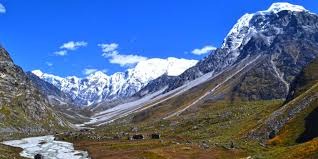The Langtang Trek in January presents a unique and serene trekking experience, characterized by winter’s beauty and challenges. This time of year is less crowded, offering a tranquil adventure amidst snow-covered landscapes.
Weather and Climate: January is deep winter in Langtang Valley, with temperatures ranging from -10°C to -5°C (14°F to 23°F) during the day, and potentially dropping below -15°C (5°F) at night. Snowfall is common, especially at higher elevations, which can significantly alter trail conditions. The air is crisp and clear, providing excellent visibility for breathtaking views of the snow-capped peaks. However, the cold and snow can make trekking challenging and necessitates extra preparation and care.
Advantages: Trekking in January offers several benefits:
- Fewer Crowds: The trails are much quieter compared to peak seasons, allowing for a more personal and tranquil experience.
- Stunning Scenery: Snow transforms the landscape into a winter wonderland, enhancing the natural beauty of the valley. The clear skies offer exceptional views of the Himalayan peaks.
- Peaceful Environment: The reduced number of trekkers provides a serene atmosphere, ideal for those seeking solitude and a deeper connection with nature.
Challenges: The primary challenges include:
- Extreme Cold: The temperatures can be harsh, requiring proper gear to stay warm and prevent frostbite.
- Snow and Ice: Snow-covered trails can be slippery and difficult to navigate. Ice can also pose additional risks, making trekking conditions more hazardous.
- Limited Facilities: Some teahouses may be closed due to low numbers of trekkers, and those that are open may have limited facilities and services.
Preparation Tips: To successfully trek Langtang Valley in January, thorough preparation is essential:
- Warm Gear: Pack insulated clothing, a high-quality down jacket, thermal layers, and waterproof outer layers to stay warm and dry.
- Footwear: Use insulated, waterproof trekking boots with good traction to handle snow and ice.
- Accommodation: Ensure advance bookings as some lodges may be closed. Carry a sleeping bag rated for cold temperatures and consider a portable heater or additional blankets.
- Health and Safety: Carry a first aid kit, altitude sickness medication, and a reliable water purification system. Hiring a local guide can enhance safety and provide navigation assistance in snowy conditions.
In summary, the Langtang Valley Trek in January offers a unique opportunity to experience the Himalayas in their winter splendor. While the trek presents challenges due to cold temperatures and snow, it also provides a serene and breathtaking adventure for those well-prepared for winter conditions.
Highlights of the Langtang Valley Trek in January
The Langtang Valley Trek in January offers a stunning winter experience. Key highlights include:
Snow-Covered Beauty: January transforms Langtang Valley into a pristine winter landscape, with snow blanketing the trails and peaks. This creates a serene and picturesque environment, ideal for photography and experiencing the Himalayas in their winter glory.
Clear Views: The crisp winter air often results in clear skies, providing unobstructed views of the snow-capped peaks and the rugged terrain of Langtang Valley. The visibility is excellent, enhancing the trek’s scenic appeal.
Quiet Trails: With fewer trekkers on the trails, January offers a peaceful and solitary trekking experience. This tranquility allows for a deeper connection with nature and a more reflective journey.
Unique Wildlife Sightings: The winter season can offer rare wildlife sightings as animals adapt to the colder weather. Keep an eye out for unique species that are less active during the busier seasons.
Why Langtang Valley Trek in January
The Langtang Valley Trek in January is ideal for those seeking a quiet, serene trekking experience. The winter season offers dramatic snow-covered landscapes, making the trek exceptionally beautiful and unique. The reduced number of trekkers allows for a more personal and undisturbed journey. Additionally, clear skies and crisp air often result in spectacular views of the Himalayan peaks. For those who can handle the cold and are prepared for winter conditions, January provides an unparalleled opportunity to experience Langtang Valley in its tranquil winter splendor.
Is it a Good Time to Trek to Langtang in January?
Trekking Langtang Valley in January can be both rewarding and challenging. The winter weather brings snow and ice, which can make trails slippery and increase the trek’s difficulty. However, if you are well-prepared for the cold and equipped with appropriate gear, January offers clear, breathtaking views and a peaceful trekking experience. The lower number of trekkers means less crowded trails, enhancing the sense of solitude and connection with nature. It is a good time for those who seek solitude and can manage the winter conditions.
How Hard is the Langtang Valley Trek?
The Langtang Valley Trek in January is considered moderate to challenging. The main difficulties are:
Extreme Cold: Daytime temperatures range from -10°C to -5°C (14°F to 23°F), and it can drop below -15°C (5°F) at night. Staying warm requires insulated clothing and proper gear.
Snow and Ice: Snow-covered trails can be slippery and difficult to navigate, increasing the risk of falls and requiring careful movement. Icy conditions add to the trek’s difficulty.
Altitude: Although not extremely high, the trek reaches altitudes where altitude sickness can occur. Proper acclimatization is necessary to mitigate this risk.
Overall, while the trek offers stunning winter scenery and solitude, it demands careful preparation and a readiness to handle cold and challenging conditions.
What Kind of Weather Do You Expect for Langtang Valley Trek in January?
In January, the Langtang Valley experiences typical winter weather conditions. Expect daytime temperatures to range between -10°C to -5°C (14°F to 23°F), with nighttime temperatures potentially dropping below -15°C (5°F). The weather is generally dry but cold, with frequent snowfall at higher elevations. Snow can cover the trails, making them slippery and challenging to navigate. Clear skies are common, offering excellent visibility and stunning winter landscapes. However, the cold and snow require careful preparation and suitable gear to ensure safety and comfort. It is advisable to monitor weather forecasts closely before and during the trek to prepare for any sudden weather changes.
Is Langtang Valley Trek Worth It?
The Langtang Valley Trek in January is highly worthwhile for those seeking a serene and unique trekking experience. The winter season brings a stunning snow-covered landscape, which is both picturesque and tranquil. Fewer trekkers on the trail mean a more peaceful and solitary adventure, allowing for a deeper connection with nature. The crisp air and clear skies enhance the breathtaking views of the Himalayas. Despite the challenges of cold temperatures and snow, the rewards include magnificent winter scenery and a sense of accomplishment from tackling a trek in challenging conditions. For adventure seekers and nature lovers, Langtang Valley in January offers a memorable and rewarding experience.
What to Pack For Langtang Valley Trek for January
Packing for the Langtang Valley Trek in January requires careful consideration due to the cold winter conditions. Essential items include:
Insulated Clothing: A high-quality down or synthetic insulated jacket to keep warm in sub-zero temperatures. Layering with thermal base layers and a fleece or wool sweater is also crucial.
Waterproof Gear: A waterproof and windproof outer layer, including a rain jacket and pants, to protect against snow and wet conditions.
Warm Footwear: Insulated, waterproof trekking boots with good traction to handle snow and ice. Warm, moisture-wicking socks are also essential.
Sleeping Gear: A sleeping bag rated for extremely cold temperatures and an insulated sleeping pad to provide warmth and comfort.
Accessories: Warm hat, gloves, and a scarf to protect extremities from the cold. Sunglasses and sunscreen are important for UV protection against reflected snow.
Other Essentials: Headlamp or flashlight with extra batteries, a reliable water purification system, and personal medications.
Weather and Temperature in January Langtang Trek
In January, Short Langtang Valley faces winter conditions characterized by cold temperatures and snow. Daytime temperatures typically range from -10°C to -5°C (14°F to 23°F), while nighttime temperatures can fall below -15°C (5°F), making it essential to be well-prepared for extreme cold. Snow is common, covering the trails and peaks, which can create both stunning scenery and challenging trekking conditions. The weather is generally dry, with clear skies often providing excellent visibility. However, snow and ice can make trails slippery, requiring careful navigation. Proper gear, including insulated clothing and sturdy footwear, is necessary to handle these conditions and ensure a safe and enjoyable trekking experience.
Food and Accommodation
On the Langtang Valley Trek, food and accommodation vary in terms of availability and quality, especially in January.
Accommodation: The trek features a range of teahouses and lodges offering basic amenities. In January, some lodges may be closed due to the lower number of trekkers, so it’s important to check availability and make advance bookings when possible. Teahouses typically provide simple rooms with shared facilities. Due to the cold, it’s wise to bring a warm sleeping bag and possibly a sleeping bag liner. Some lodges may offer additional blankets or heating options, but these can be limited.
Food: Teahouses along the trail serve a variety of meals. In January, the food options may be more limited compared to peak seasons. Typical offerings include dal bhat (rice and lentil soup), noodles, soups, and basic international dishes. Meals are generally hearty but simple. Due to fewer trekkers, it’s a good idea to carry some extra snacks and energy bars. Ensure you stay hydrated and well-nourished to cope with the cold and demanding trek.
Guide and Porter
Hiring a guide and porter for the Langtang Valley Trek is highly recommended, especially in January when conditions can be more challenging.
Guide: A local guide offers invaluable assistance with navigation, ensuring safety on snowy and icy trails. They can also provide cultural insights and local knowledge, which enhances the trekking experience. Guides are experienced in handling winter conditions and can help manage any unexpected issues that may arise due to the weather.
Porter: A porter carries your heavier gear, making the trek more manageable. This is particularly important in winter when carrying extra layers and equipment is necessary. Porters are familiar with the conditions and can assist in maintaining a steady pace.
Transportation for Langtang Trek
To reach the Langtang Valley for the trek, you’ll need to arrange transportation from Kathmandu to Syabrubesi, the starting point of the trek.
Local Bus: The most economical option is a local bus, which departs from Machha Pokhari bus park in Kathmandu. The journey to Syabrubesi takes about 7-9 hours, passing through winding mountain roads.
Private Vehicle: For a faster and more comfortable option, hiring a private jeep or car is recommended. This can reduce travel time to approximately 5-6 hours and offers a more direct route.
Local Transport in Syabrubesi: Once you arrive in Syabrubesi, transportation beyond this point is not necessary, as the trek begins here. Make sure to arrange your transport in advance and check the vehicle’s condition, as road conditions can be challenging in winter.
Conclusion
The Langtang Valley Trekking offers a unique winter experience in January with its stunning snow-covered landscapes and serene environment. Despite the challenges posed by cold temperatures and snow, careful preparation can make the trek rewarding. Ensuring you have appropriate food and accommodation is crucial, as January can see limited options. Hiring a guide and porter enhances safety and convenience, especially in winter conditions. Proper transportation planning is essential to reach the trek’s starting point. With the right gear, planning, and support, the Langtang Valley Trek in January provides a memorable adventure in one of Nepal’s beautiful valleys.





